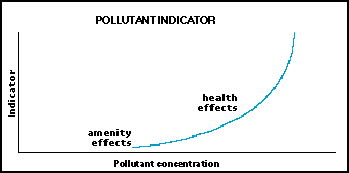
Paper presented at
SCOPE SCIENTIFIC WORKSHOP ON
INDICATORS OF SUSTAINABLE DEVELOPMENT
(Wuppertal, Germany, 15-17 November 1995)
Arthur Lyon Dahl
United Nations Environment Programme
Geneva, Switzerland
Introduction
The concept of sustainability
The dimensions of sustainability
The temporal dimension
Beyond sustainability to sustainable development
The varieties of sustainable development
Indicating sustainability
Figures 1-3 - Unsustainability Indicators
Figures 4-5 - Trajectories to Sustainability Targets
Sustainable development has become the catch word of our decade, used and mis-used in many contexts. Yet it has been notoriously difficult to define, not to mention to translate into other languages. If we are going to produce effective indicators of sustainable development, we must agree on what we are trying to indicate.
This is not the place to review the dozens if not hundreds of definitions of sustainable development and to try to agree on a precise wording. We need to aim for a working consensus on what we are trying to measure. It may therefore be more useful to start by exploring the major dimensions of sustainability that might need to be included, and then to try to formulate a working definition that helps us to focus on the form and content of indicators and indices. We also should identify those aspects that would be inappropriate to include in a global definition of sustainable development. We can then ask if there are particular formats for indicators that are most appropriate to communicate the concept of sustainability.
Reference to sustainable development implies a central focus on people. Our society, of course, functions in a natural environment, uses resources and discharges wastes; it is not separate from the natural world. However, we should agree that, in the present context, the sustainability we are seeking is that of human society as it depends on and is intimately interrelated with natural systems. This may be seen as anthropocentric, but, in the present context of the international debate on development and equity, any other approach could be considered morally indefensible.
In a dynamic system like human society, sustainability is fundamentally a question of balance maintained over time. It is thus something that cannot easily be scaled and measured, since it is a quality of motion rather than a fixed point. It may be more easily defined in practice as the lack of forces tending to upset an equilibrium over time. This is why most indicators are in fact measures of unsustainability, i.e. the amount or extent of imbalances. As with a moving pendulum or an aircraft in flight, many different forces can act simultaneously to disturb an equilibrium; if one such force is reduced or eliminated, others become predominant. Only when all forces upsetting the balance are removed can sustainability be achieved.
Because sustainability is dynamic, it includes several characteristics, such as the speed or rate of change, the size of the mass involved in the change and thus the inertia of the process, and the significance of the amount and rate of change relative to the initial and resulting states. For instance, in determining the sustainability of a renewable resource harvest, it would be important to know the rate of harvest and the amount harvested over a given period, relative to the total stock of the resource at the beginning and end of the period, and the rate of resource regeneration over the same period.
In any community or economic system, there can be many kinds or sources of unsustainability, such as the limited size of a resource, inadequate supply inputs or excessive demand for outputs, damaging pressures such as pollution, etc. Some of these may be controllable within the system, while others are subject to outside pressures. Since most systems are complex and not well understood, cause and effect relationships are not always apparent. The challenge in developing indicators of sustainability is to find simple ways of presenting this concept despite the complexity and uncertainty.
While planners and politicians tend to look only five years ahead, and see the long term as twenty years, it would seem reasonable in the context of global systems and resources to view sustainability as stretching into the indefinite future, say up to half a million years, as a reasonable time span over which our actions should not be constraining future society. This will help to avoid the tendency to discount the long-term future, and will require that adequate consideration be given to fundamental if gradual processes of global balance and change.
There are as many potential dimensions to sustainability as there are important dimensions of any human society. Accountants think in terms of fiscal sustainability, such as in accounts where the deposits plus interest must balance the withdrawals plus charges. A financial debt is a constraint imposed in the present on our future ability to meet needs, and to the extent that the present advantage procured is insufficient to reimburse the debt, it is by definition unsustainable. Economists have a slightly broader view of economic sustainability that includes the maintenance of assets and capital value and productivity through investments at least equal to depreciation.
There is much concern today over the ecological sustainability of human development on this planet, with population growth and resource consumption drawing down stocks of natural resources and their renewable productive potential, while increasing wastes further damage natural systems and upset essential life support processes such as the carbon cycle and the maintenance of stratospheric ozone. We are in fact accumulating resource debts and pollution debts that can only be eliminated through extensive future investments. Many ecological processes are so complex and so poorly understood that it will be very difficult to derive indicators of ecological sustainability. At best, given present knowledge, we can use indicators of unsustainable pressures and impacts, which should be minimized in a precautionary approach to the management of such complex systems.
While there are now some indicators of human development, we have not yet really touched on what might be called human sustainability, and not just in the sense of population numbers or balance. People require education and training to develop their potential to become productive members of society. This is an investment like any other, and the poverty that results from the failure to make that investment and to provide people with the means of livelihood is as much a kind of debt as a financial one, representing a burden of wasted potential weighing on the future. Since the human life-span is limited, the educational investment in individuals is ultimately depreciated and lost. Sustainability in human terms thus includes those educational and cultural processes that preserve human knowledge and ensure its transmission from generation to generation. Can we indicate whether one generation knows more that a preceding one? What are the trends? Knowledge in science and technology may be increasing, but other kinds of knowledge and experience are being lost. The whole domain of human culture and knowledge is a critical yet undervalued and unmeasured dimension of development and thus of sustainability. Is there some way to indicate balance here as a guide to management action?
There are also those dimensions that could be referred to as social sustainability, which may be just as crucial to what we should define as development, but which have largely escaped existing systems of measurement and accountability. A developed society, for instance, is characterized by an elaborate legal system, built up over generations of legislative additions and judicial interpretations. This also is an investment in what should be considered an important part of national wealth, if only judged by its replacement value. Yet societies change and laws are dynamic. Can we measure how well a legal system is meeting social needs, or perhaps has become so cumbersome that it is a counter-productive weight on society? Also, communities are structured into various types of institutions ranging from governmental bodies through corporations to informal associations and religious organizations. Do we have measures of the effectiveness of this social structuring, the processes of communications and decision-making that take place within them, and their evolution over time? Is social cohesion increasing or diminishing? Measures in this area might be enlightening.
One could even extend this view to what might be called moral, ethical or spiritual sustainability. An effective society depends on a shared set of values or ethical principles that define what is acceptable behaviour between individuals, and that motivate people to work together in the common interest. Such values are the basic rules for human interaction, and thus an essential support to development. A society that is losing its moral core may appear materially successful before declining into anarchy. In theory, at least, this should also be included in a broad concept of the sustainability of human society, even if the practical problems of developing indicators in this area are daunting.
Any comprehensive approach to indicators for sustainable development must include both new kinds of indicators that account for the multiple interrelated dimensions of any society that should fall within the concept of development, and new ways of accounting for sustainability over time. It is not just what we put in the accounts, and what indicators we use, but how we use them that is important.
To incorporate the sense of time, we need a new kind of accounting, bringing in the temporal dimension, in what might perhaps be called "chrono-economics". Any measure of balance cannot look only at the static situation at one moment, but must look at measures integrated over time to document processes and trends. Such accounts should include past trends leading up to the present, and projections of what the future will require to achieve or maintain sustainability. Present economic balance sheets are thus doubly flawed; they exclude many capital stocks and flows as externalities, and they are not adequately summed over time, particularly with respect to the future implications of the present situation.
Nothing is permanent on this planet. Wealth is created and destroyed; energy is degraded; materials are concentrated and dispersed; useful information is increased and lost; things wear out; objects and materials have a useful life and then become wastes with disposal or recycling costs; old technologies are replaced by new ones. Ageing and death are as much a part of life as reproduction and growth. Sustainability requires accounting for all of this over time. For the ultimate balance to be sustainable, the processes of maintenance, replacement and renewal must equal or exceed the processes of depreciation, degradation and loss.
We cannot automatically assume that capital replacement will take place. It requires investment, and may have preconditions which have to be taken into account. We can make some reasonable assumptions over the next 80-100 years for those people now alive, disallowing the possibility of a cataclysm, but can we be so certain about future birth rates. For instance, what if there were widespread sterilization of males by some common pollutant? Can we assume the maintenance of agricultural productivity into the future if soils are eroding, new diseases are evolving, the genetic resource base is shrinking or being privatized, and research is declining, i.e. the necessary investments are not being made to maintain the productive potential?
Industry may invest in a factory with a 30 year productive life over which its depreciation is calculated and its potential profits determined, but if a new technology makes the product obsolete in 5 years, 25 years of investment will be wasted and lost. The rapid growth rate of technological innovation can be counter-productive economically in terms of capital accounts integrated over time, by rendering investments obsolete prematurely.
In a stable ecosystem like a mature forest, the total productive potential is the sum of the primary productivity of all the forest plants, based on their trapping the maximum amount of incoming sunlight. Since individual trees (and other plants) grow and die, the total productivity at any one point in time is the sum of all the trees regardless of their stages of growth, from seedlings to senescent old snags. The sustainability is the replacement process by which new trees grow to fill in the canopy and replace any that are lost.
Any accounting system for sustainability must be able to spot failures to reinvest, and damage to future productive potential, and their resulting impact on the integrated total productivity over time. This requires accounts that show all existing investments, capital stocks and productive capacity, and the actual present rate of production (which is often well below the peak capacity). They should incorporate projected depreciation, and necessary investments for maintenance, renewal or replacement, in a kind of extended life cycle accounting. The quality of the investment becomes important here, as durability is valued. It will be necessary to model technological innovation and its impact, insofar as there are rational bases for predicting this. An integrated accounting methodology should try to take into account all significant interactions, such as damage caused by one activity (say pollution from industry) on another (perhaps agricultural production). It should include available human skills and knowledge, and their replacement with changing generations.
Such integrated accounting over time should help to eliminate unrealistic assumptions about the future, by incorporating the real dynamics of possible rates of change and the capacities of systems and resources, such as water resources, primary productivity, available land area, population size and density, etc. One critical factor will be the energy throughput, including both renewable and non-renewable sources. The sum of the dynamic indicators for the movements over time of all these dimensions of our total accounts will begin to define real sustainability.
It is possible that, on this new basis, some of the industrialized "developed" countries will show frighteningly unsustainable accounts, which would demonstrate that their prosperity is based on heavy borrowing from future potential, or is relying on highly optimistic assumptions about technological replacements which will in any case require difficult and expensive industrial and social transitions.
To begin to address what is fundamentally involved in sustainable development, it will be necessary to distinguish the various kinds of economic activity and the wealth they create. We need measures of what might be called real or "strong" development, as compared to the simple economic activity or turn-over measure of GNP. Transfers or redistributions from one account or place to another are not in themselves wealth creation; they may represent equal exchanges, or increasing wealth compensated by a corresponding increase in poverty. Harvesting bananas cheaply in Central America and delivering them to a European table may raise their price, but does not really generate wealth, as the price increase would just reflect the transport, storage, middle-man costs and increased profit margin. The intrinsic value of the bananas for nutrition is the same; only the scarcity and willingness/ability to pay have changed with the location. Real value added comes from primary productivity or from transformation or processing to add functionality, utility, durability, or other kinds of information content. To determine real value, every cost and input should be accounted for, and hidden subsidies in particular should be avoided.
The maintenance of capital is also not net wealth creation or real development. It is running in order to stand still. One does not become wealthier by replacing a leaking roof, filling potholes in the street, washing the dishes, cleaning up pollution, or buying a replacement vehicle. Real development is only when new value is added by innovation or creation, the quality of life is increased, or a larger net mass of goods and services is produced and maintained, after all the costs of production and depreciation have been subtracted. This will most likely be both a much lower percentage growth, and involve different kinds of growth, than that measured today using GNP indicators.
This lower real or net approach to growth may have important implications for national interest rates and thus for calculations of sustainability in development. The real rate of interest on capital should probably not exceed the real rate of creative wealth generation by that capital. Most of what goes into today's interest rates and rates of return on investments are "growth opportunities" that either compensate for inflation or represent hidden resource transfers and subsidies produced by failures in true accounting. They come, for instance, from treating natural capital resources as externalities or from exploiting the disadvantaged situations of poorer countries or social groups. They thus give a false impression of what is really increasing or developing.
The present economic system of accounting and indicators has produced a financial system which manufactures money as a commodity, through credit mechanisms that allow cumulative borrowing and re-borrowing, aided by banking and accounting delays and manipulations. As money circulates, particularly through electronic accounts, it multiplies by the play of interest rates and layer upon layer of debts in more and more compartments of the system: government debt, corporate debt, consumer debt, resource debts, etc. Does the present system of accounts add up all those debts across the whole society and place them against net assets valued over time? Does it identify real wealth creation, investment and maintenance rates as compared to debt, depreciation and resource draw-down rates? Are there indicators for all the key components in this process? These are examples of the complex issues that must be faced if indicator systems are to approach the real nature of sustainable development.
One thing that should be obvious in this broad view of the dimensions of sustainability is the danger of using indicators to make value judgements about the content of development. There is great suspicion among some developing countries and cultures that environmental and sustainable development indicators will be used to force some western set of values on them or to impose conditionality.
This problem is aggravated by the fact that, to be useful, indicators need to be evaluated relative to some target or limit. Yet setting such targets involves value judgements that are inherently culture-bound. If they are to be globally relevant, indicators of sustainability must be so designed that they have sufficient flexibility to measure common themes, dimensions or trends of sustainability while remaining culturally appropriate everywhere. They should be capable of covering the full spectrum of interests from the "super powers" to the small island developing States, from indigenous subsistence to post-industrial communities, and from high-tech to no-tech situations. For environmental indicators, there may be an objective scientific basis for setting targets or limits, such as the level of pollution causing health effects, the reduction in chlorinated compounds necessary to protect the ozone layer, or the amount of forest cover necessary to maintain a particular level of water flow in a catchment. At least science can define a gradient of environmental quality along which each society can set its appropriate limit. However, on the social and economic side, limits or targets are much more value-laden and thus indicators cannot be absolute but must be relative to each society's concepts, goals and values. They can only be decided within a country or culture, and preferably on the basis of wide consultation and participation. For this reason, the concept of international performance indicators for sustainable development is, at least at present, politically unacceptable. States do not want anyone else judging their performance or the way they define development, and they want to choose how to report their progress in international forums such as the Commission on Sustainable Development. An emphasis on the concept of sustainability as a dynamic balance over time may help to avoid this problem.
One way to express the concept of sustainability without falling into value judgements about development will be to produce "vector" indicators which basically show the direction of movement towards or away from a goal, and the speed of that movement. Such indicators will allow each country to define for itself how it imagines its ideal future sustainable society (in itself an instructive exercise), and then to report, for each indicator, whether it is making progress towards its own goal, and at what rate. For instance, a country could determine what would be its optimal human population size, calculate the population growth curve necessary to stabilize numbers at that size, and then use as an indicator a measure of the deviation of its actual population curve from that necessary to reach its own target. A policy maker could thus see immediately whether the trend is going in the right direction, and how many years it will take to achieve the desired result. The goals or targets so set at the national level will need to be flexible and subject to change as technological possibilities, new discoveries and social visions change. For a dynamic process like the sustainability of development, it is normal to have a moving target. Since sustainability is itself difficult to define, and most present indicators in fact measure negative factors or pressures preventing sustainability, vector measures allow countries to report, for instance, the progress they are making in reducing damaging activities, even if they have not yet defined clear goals for sustainability.
Another factor to consider in designing indicators of sustainability is the relative weight to give to different indicators. Again, the concept of sustainability as a process of balance can help to suggest a solution. Indicator values can be ranged on a non-linear scale, where more extreme problems or larger deviations from the desirable level carry more weight than small deviations. This weighting should be calculated according to the specific characteristics of each phenomenon.

A pollution indicator (Figure 1) might have no significance at low concentrations, might rise somewhat as moderate levels of pollution affect amenity values, and then increase sharply as the pollutant causes health impacts at high concentrations. Depleting the first 5% of a resource (Figure 2) may have little significance, while depleting the last 5% may have enormous impact.
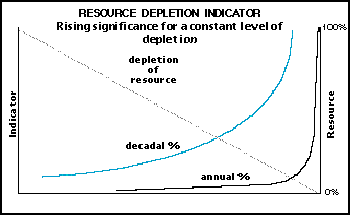
There may be an optimum indicator level (Figure 3), with deviations in either direction becoming increasingly harmful. One extreme problem (and thus its indicator) may in fact be much more threatening to sustainability than a large number of minor problems. The use of such non-linear scaling can facilitate the rational aggregation of indicators, since it provides a more objective criterion for relative weighting than an arbitrary combination or equal treatment. Each indicator, in effect, weighs itself according to the significance of its impact.
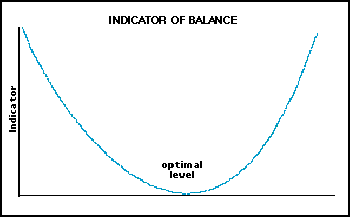
We should try to develop standard graphic forms to plot indicators of sustainability. Several characteristics need to be incorporated into such plots to illustrate the way the idea of sustainability can be communicated through indicator series over time. In addition the significance or impact curve mentioned above and illustrated in Figures 1 to 3, graphs make it possible to illustrate the time dimension and trends clearly.
First, the particular target that has been set locally for the indicator should be combined with an ideal trajectory of the indicator to reach the target at the time agreed (Figures 4 and 5) .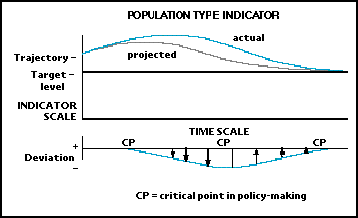
If this trajectory to sustainability is agreed as part of the planning process, it will help decision-makers to visualize the commitment they are making and the effort required to achieve their goal. It will then be possible to plot the deviation of the actual situation or location of the indicator relative to the ideal level or trajectory set by policy. This can be a deviation both in the value of the indicator (above or below the target) and it its vector, that is whether it is moving in the right or the wrong direction, and at what speed. It is the direction and speed of the indicator vector as well as its location that really begin to define sustainability as a dynamic concept. They should be scaled or weighted in value according to the importance of the deviation.
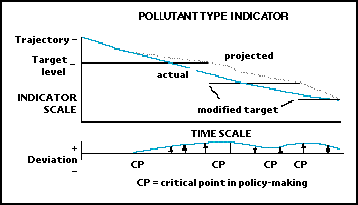
The final element which may be of greatest interest to policy-makers is the second order vector which might be called the response effectiveness indicator (shown at the bottom of Figures 4 and 5). This is simply the measure of how the indicator vector is changing (slowing down, speeding up, changing direction), since this is a measure of the effectiveness of whatever actions have been taken. This indicator shows quickly whether the management actions are sufficient or whether further effort is required
It would be desirable to agree as far as possible on standard ways to express sustainability indicators to make them easily understandable and widely recognizable. Such indicators could be developed not only as numbers and graphic representations, but also on scales and even colour codes that would make it easier to communicate them or to map them to show distributions in space. Indicators could be scaled as a percentage ranging from 100 for full sustainability to 0 for total unsustainability or collapse. Another measure could be the number of years to achieve sustainability (for positive trends) or absolute unsustainability for negative trends, around a central point where the vector changes direction at 10, 100 or 1000 years depending on the phenomenon. A colour scale could range from white for full sustainability through yellow and green for improvement and violet and red for degradation to black for complete unsustainability or collapse, with the colour density selected to produce comparable shades of grey when reproduced in black and white. Arrows or other symbols could also communicate vector indicators. Such a standardized language or scale for indicators of sustainability could be used for any factor at any geographic scale at which indicators need to be determined, and would communicate indicator results in a simple graphic fashion easier for non-specialists and the public to understand. Sustainability may be a complex concept, but this does not mean that indicators of sustainability cannot have an immediate direct meaning for everyone concerned.
Our challenge is that indicators of sustainable development are being pushed by political demand despite the hesitancy of experts and scholars to tackle questions that involve human values and political processes as much as or more than scientific methodologies. The above reflections and proposals may suggest a satisfactory way forward. We must rise to the challenge and work to develop indicators that can themselves become the driving forces towards a truly sustainable society.
Significance or impact curves to provide non-linear scaling
FIGURE 1 - Pollutant Indicator





This paper was originally posted on the UN System-wide Earthwatch web site. Other versions were published in Arthur Lyon Dahl (1996), "Measuring the unmeasurable". Our Planet 8(1): 29-33; and Arthur Lyon Dahl (1997) "The Big Picture: Comprehensive Approaches - Introduction." Chapter 2, p. 69-83, and "From concept to indicator: dimensions expressed as vectors." Box 2H, p. 125-127 in Bedrich Moldan, Suzanne Billharz and Robyn Matravers (eds), Sustainability Indicators: A Report on the Project on Indicators of Sustainable Development. Scientific Committee on Problems of the Environment, SCOPE 58. John Wiley & Sons, Chichester.
Published on line by International Environment Forum: https://iefworld.org/ddahl95b.htm
Return to Bibliography page